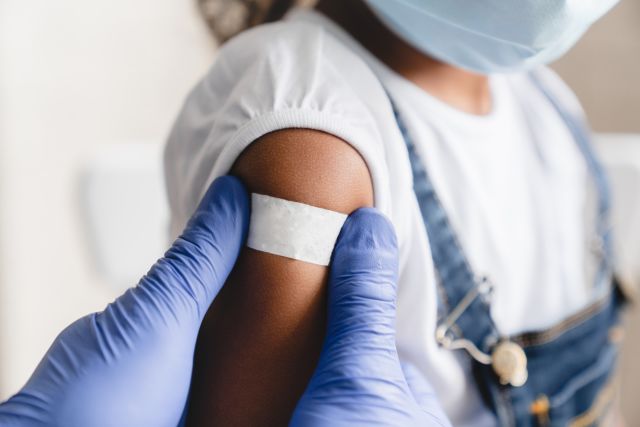Updated on March 15, 2024.
After years of progress, cases of measles in the United States and other parts of the world are on the rise as the number of children receiving the vaccine that protects against this disease has declined.
In 2022, global measles cases increased by 18 percent to 9 million, and deaths increased by 43 percent to 136,000, compared to the year before, according to a November 2023 report from the World Health Organization (WHO) and the U.S. Centers for Disease Control and Prevention (CDC).
Why vaccination rates are down—and cases are up
Some 25 million kids missed their first dose of the two-dose MMR (measles-mumps-rubella) vaccine, and another 14.7 million missed their second MMR shot due to disruptions in routine childhood vaccinations during the COVID pandemic, a 2022 report from the WHO and CDC showed. This disruption left nearly 40 million children around the world are at risk for measles.
“The paradox of the pandemic is that while vaccines against COVID-19 were developed in record time and deployed in the largest vaccination campaign in history, routine immunization programs were badly disrupted, and millions of kids missed out on life-saving vaccinations against deadly diseases like measles,” said WHO Director-General Dr Tedros Adhanom Ghebreyesus. “Getting immunization programs back on track is absolutely critical.”
But even before the pandemic began, prevailing myths and misconceptions about vaccine safety also played a role. Some people forego immunizations for their children simply for personal reasons, such as their religious views. The fact that most Americans alive today don’t have firsthand knowledge of devastating diseases, like polio and smallpox, may also contribute to lagging vaccination rates in some parts of the country.
Measles can spread anywhere there are “pockets of unvaccinated people,” the CDC explains. This includes the U.S. as well as other parts of the world. Anyone who travels to countries where measles outbreaks are happening can also bring the disease back to their own community.
At least 95 percent of the population must be fully vaccinated against measles to establish herd immunity, the point at which the spread of a disease is unlikely because enough people survive infection and/or get vaccinated against it.
Research conducted during the COVID pandemic suggest the public health emergency disrupted routine childhood vaccination. In 2020, the percentage of children around the world who were vaccinated against measles dropped to 84 percent.
The latest CDC statistics show that about 91 percent of children are vaccinated against measles by the age of 2. But another 2020 model-based study found that a continuing reduction of measles vaccinations among 1-year old children in the United States could push vaccination rates below 80 percent.
“Measles anywhere is a threat everywhere, as the virus can quickly spread to multiple communities and across international borders,” the CDC cautions.
Protect yourself and your community
You can protect yourself, your family, and your community by learning about measles and how to prevent it from spreading.
What is measles?
Measles (rubeola) is a serious and sometimes fatal respiratory disease that’s caused by a virus. Worldwide, it is still one of the leading causes of death in children.
How does it spread?
An infected person can pass the virus, usually by coughing or sneezing, up to four days before and after the trademark red rash appears. Measles droplets from an infected person can linger in the air for hours. Unvaccinated people who inhale contaminated droplets or touch an infected surface and then touches their nose or mouth can become infected. Once people are vaccinated against measles, they become immune to it and can’t pass it on to others. Antibodies are generally detectable a few days after vaccination, and people are usually fully protected within 2 to 3 weeks.
As more people have been vaccinated against the disease over the past several decades, it has had fewer opportunities to spread.
Who’s at risk?
Any child or adult who is not vaccinated is at risk, especially if they travel internationally in countries where measles is still common or if they visit areas in the U.S. where outbreaks have been reported.
What are the signs and symptoms?
Measles symptoms occur in stages, beginning with a high fever accompanied by a runny nose, cough, and watery eyes. Tiny white spots may appear in the mouth a couple of days later. An itchy red rash follows in three to five days, starting at the hairline and spreading down toward the feet.
Is getting measles dangerous?
Before the vaccine that protects against measles was licensed back in 1963, the CDC estimates that three to four million people were infected annually, and hundreds of people died from the infection. Measles can lead to serious complications or even death. There is no cure for the virus or treatment that can shorten the length of the infection. Once a person becomes infected, complications may include pneumonia, severe diarrhea, ear infection, and swelling of the brain.
Measles can be serious for anyone but certain groups are more likely to develop complications, including:
- Children younger than 5
- Adults older than 20
- Pregnant people
- People with weakened immune systems
The infection is managed with supportive care to ease symptoms, such as IV fluids, antibiotics (to treat a bacterial infection that may develop in addition to the measles infection).
How can you avoid infection?
Measles is one of the most contagious known human viruses, but it’s almost entirely preventable through widespread vaccination. The MMR (measles, mumps, rubella) vaccine is given in two shots, the first around the age of 12 to 15 months, the second around 4 or 6 years old. Early vaccination is the best way to protect yourself and others. Adults who aren’t immune should get at least one dose of the MMR vaccine.







